Case Analysis Regarding Contract Law
VerifiedAdded on 2022/08/26
|7
|1917
|26
AI Summary
Contribute Materials
Your contribution can guide someone’s learning journey. Share your
documents today.
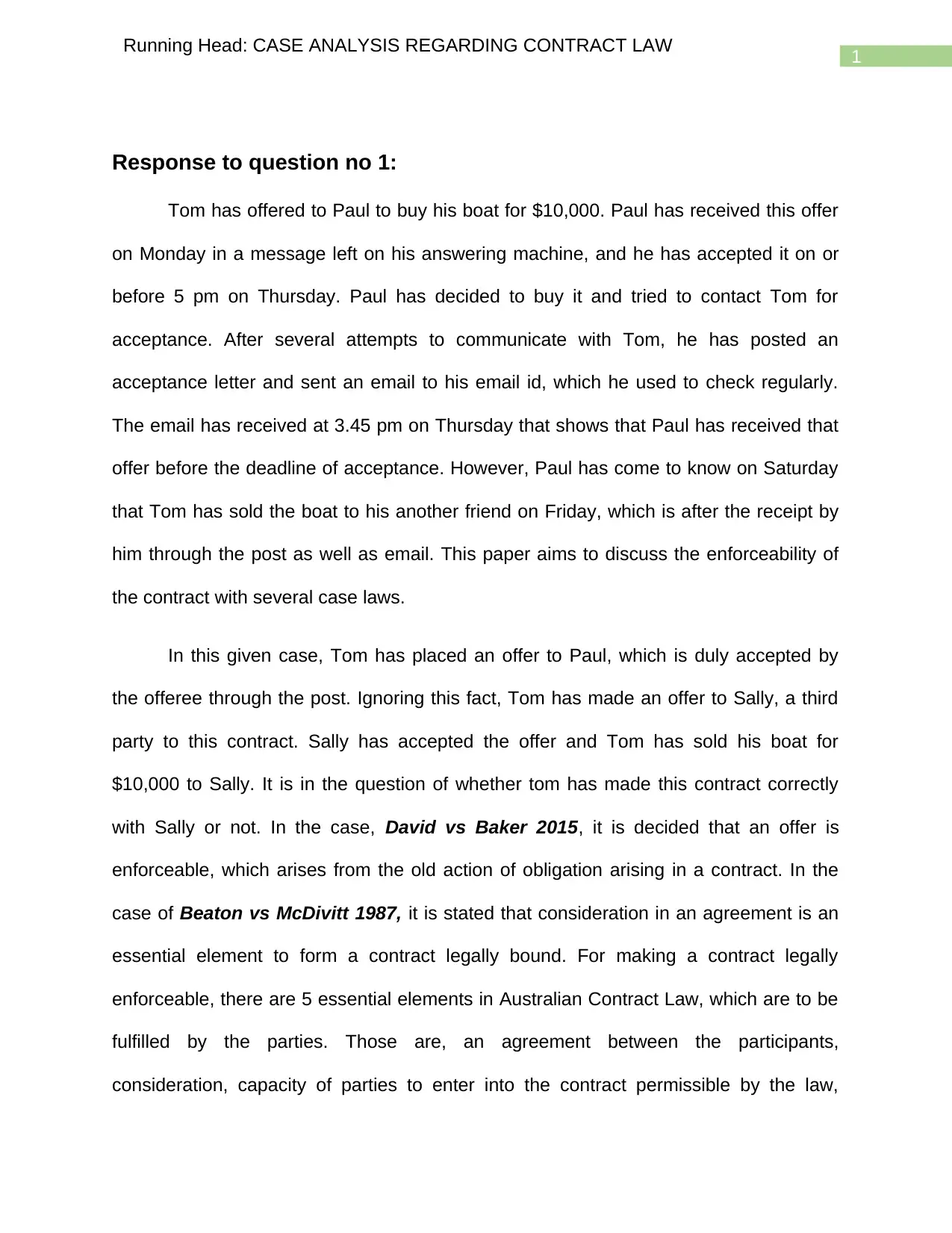
1
Running Head: CASE ANALYSIS REGARDING CONTRACT LAW
Response to question no 1:
Tom has offered to Paul to buy his boat for $10,000. Paul has received this offer
on Monday in a message left on his answering machine, and he has accepted it on or
before 5 pm on Thursday. Paul has decided to buy it and tried to contact Tom for
acceptance. After several attempts to communicate with Tom, he has posted an
acceptance letter and sent an email to his email id, which he used to check regularly.
The email has received at 3.45 pm on Thursday that shows that Paul has received that
offer before the deadline of acceptance. However, Paul has come to know on Saturday
that Tom has sold the boat to his another friend on Friday, which is after the receipt by
him through the post as well as email. This paper aims to discuss the enforceability of
the contract with several case laws.
In this given case, Tom has placed an offer to Paul, which is duly accepted by
the offeree through the post. Ignoring this fact, Tom has made an offer to Sally, a third
party to this contract. Sally has accepted the offer and Tom has sold his boat for
$10,000 to Sally. It is in the question of whether tom has made this contract correctly
with Sally or not. In the case, David vs Baker 2015, it is decided that an offer is
enforceable, which arises from the old action of obligation arising in a contract. In the
case of Beaton vs McDivitt 1987, it is stated that consideration in an agreement is an
essential element to form a contract legally bound. For making a contract legally
enforceable, there are 5 essential elements in Australian Contract Law, which are to be
fulfilled by the parties. Those are, an agreement between the participants,
consideration, capacity of parties to enter into the contract permissible by the law,
Running Head: CASE ANALYSIS REGARDING CONTRACT LAW
Response to question no 1:
Tom has offered to Paul to buy his boat for $10,000. Paul has received this offer
on Monday in a message left on his answering machine, and he has accepted it on or
before 5 pm on Thursday. Paul has decided to buy it and tried to contact Tom for
acceptance. After several attempts to communicate with Tom, he has posted an
acceptance letter and sent an email to his email id, which he used to check regularly.
The email has received at 3.45 pm on Thursday that shows that Paul has received that
offer before the deadline of acceptance. However, Paul has come to know on Saturday
that Tom has sold the boat to his another friend on Friday, which is after the receipt by
him through the post as well as email. This paper aims to discuss the enforceability of
the contract with several case laws.
In this given case, Tom has placed an offer to Paul, which is duly accepted by
the offeree through the post. Ignoring this fact, Tom has made an offer to Sally, a third
party to this contract. Sally has accepted the offer and Tom has sold his boat for
$10,000 to Sally. It is in the question of whether tom has made this contract correctly
with Sally or not. In the case, David vs Baker 2015, it is decided that an offer is
enforceable, which arises from the old action of obligation arising in a contract. In the
case of Beaton vs McDivitt 1987, it is stated that consideration in an agreement is an
essential element to form a contract legally bound. For making a contract legally
enforceable, there are 5 essential elements in Australian Contract Law, which are to be
fulfilled by the parties. Those are, an agreement between the participants,
consideration, capacity of parties to enter into the contract permissible by the law,
Secure Best Marks with AI Grader
Need help grading? Try our AI Grader for instant feedback on your assignments.
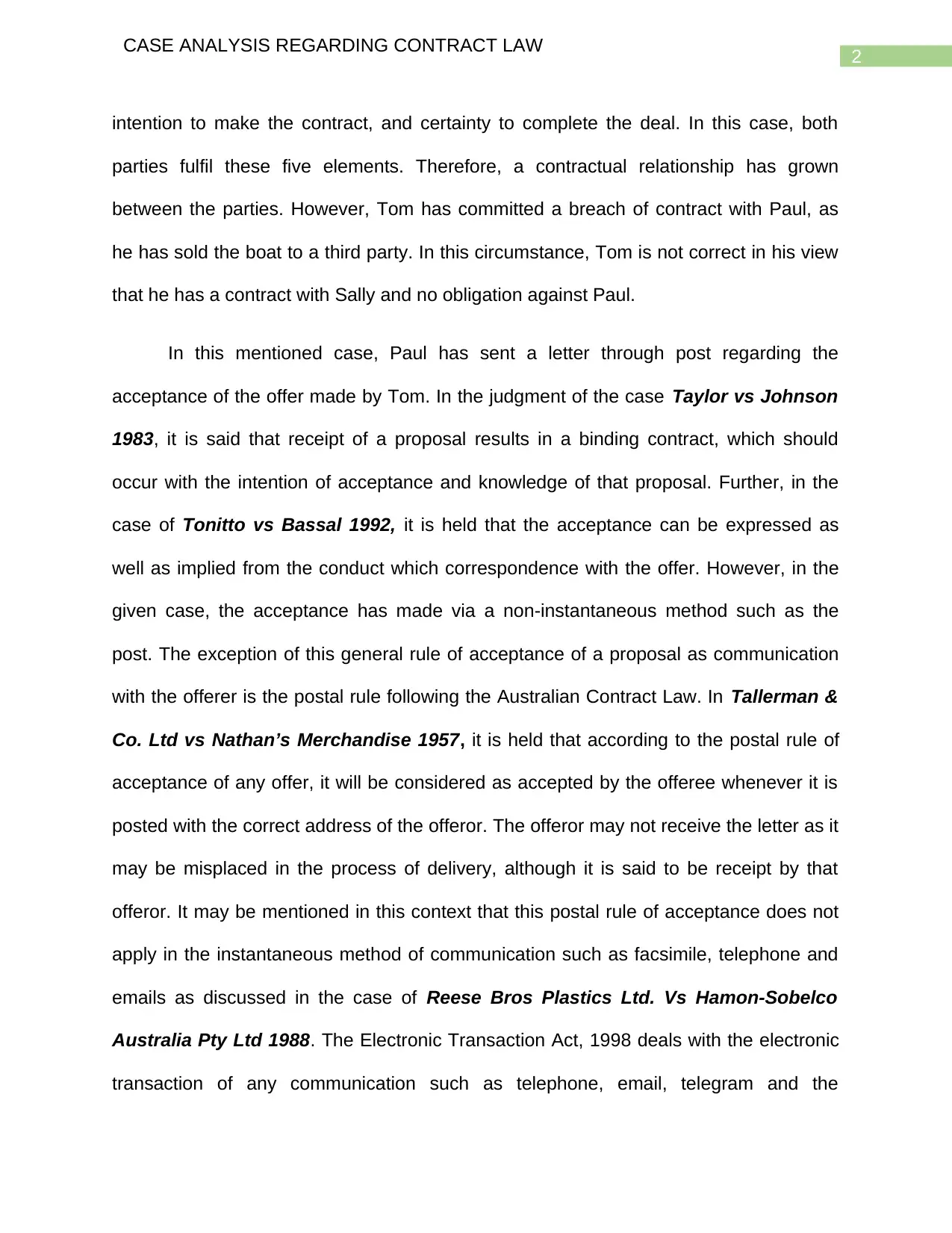
2
CASE ANALYSIS REGARDING CONTRACT LAW
intention to make the contract, and certainty to complete the deal. In this case, both
parties fulfil these five elements. Therefore, a contractual relationship has grown
between the parties. However, Tom has committed a breach of contract with Paul, as
he has sold the boat to a third party. In this circumstance, Tom is not correct in his view
that he has a contract with Sally and no obligation against Paul.
In this mentioned case, Paul has sent a letter through post regarding the
acceptance of the offer made by Tom. In the judgment of the case Taylor vs Johnson
1983, it is said that receipt of a proposal results in a binding contract, which should
occur with the intention of acceptance and knowledge of that proposal. Further, in the
case of Tonitto vs Bassal 1992, it is held that the acceptance can be expressed as
well as implied from the conduct which correspondence with the offer. However, in the
given case, the acceptance has made via a non-instantaneous method such as the
post. The exception of this general rule of acceptance of a proposal as communication
with the offerer is the postal rule following the Australian Contract Law. In Tallerman &
Co. Ltd vs Nathan’s Merchandise 1957, it is held that according to the postal rule of
acceptance of any offer, it will be considered as accepted by the offeree whenever it is
posted with the correct address of the offeror. The offeror may not receive the letter as it
may be misplaced in the process of delivery, although it is said to be receipt by that
offeror. It may be mentioned in this context that this postal rule of acceptance does not
apply in the instantaneous method of communication such as facsimile, telephone and
emails as discussed in the case of Reese Bros Plastics Ltd. Vs Hamon-Sobelco
Australia Pty Ltd 1988. The Electronic Transaction Act, 1998 deals with the electronic
transaction of any communication such as telephone, email, telegram and the
CASE ANALYSIS REGARDING CONTRACT LAW
intention to make the contract, and certainty to complete the deal. In this case, both
parties fulfil these five elements. Therefore, a contractual relationship has grown
between the parties. However, Tom has committed a breach of contract with Paul, as
he has sold the boat to a third party. In this circumstance, Tom is not correct in his view
that he has a contract with Sally and no obligation against Paul.
In this mentioned case, Paul has sent a letter through post regarding the
acceptance of the offer made by Tom. In the judgment of the case Taylor vs Johnson
1983, it is said that receipt of a proposal results in a binding contract, which should
occur with the intention of acceptance and knowledge of that proposal. Further, in the
case of Tonitto vs Bassal 1992, it is held that the acceptance can be expressed as
well as implied from the conduct which correspondence with the offer. However, in the
given case, the acceptance has made via a non-instantaneous method such as the
post. The exception of this general rule of acceptance of a proposal as communication
with the offerer is the postal rule following the Australian Contract Law. In Tallerman &
Co. Ltd vs Nathan’s Merchandise 1957, it is held that according to the postal rule of
acceptance of any offer, it will be considered as accepted by the offeree whenever it is
posted with the correct address of the offeror. The offeror may not receive the letter as it
may be misplaced in the process of delivery, although it is said to be receipt by that
offeror. It may be mentioned in this context that this postal rule of acceptance does not
apply in the instantaneous method of communication such as facsimile, telephone and
emails as discussed in the case of Reese Bros Plastics Ltd. Vs Hamon-Sobelco
Australia Pty Ltd 1988. The Electronic Transaction Act, 1998 deals with the electronic
transaction of any communication such as telephone, email, telegram and the

3
CASE ANALYSIS REGARDING CONTRACT LAW
acceptance through these communications are different from the postal rule. In the
given case in question, Paul has accepted the offer through the email as well as post.
The email also duly received by the offerer. Therefore, Tom appropriately receives the
acceptance of the proposal through the instantaneous method as well as the non-
instantaneous method. By this acceptance of the offer made by Tom, a contractual
relationship has completed between him and Paul. Therefore, in this case, Paul has a
contract with Tom and Tom is liable for breach of contract.
Response to Question No. 2:
In this case, Mr. and Mrs Rossi sold to Mr. Greg an olive grove situated in the
region of Hunter Valley, New South Wales for $850,000. Mr. Greg used to look after the
business affair of the couple. They used to trust Mr Greg since they came from their
hometown Italy. They trusted Mr. Greg about the estimation of the property and believed
that the deal was fair. It came to their knowledge after selling the property that the price
of the property is much higher than the selling amount. Later, Greg sold the same
property for $1.5million. The idea of this study is to find out legal remedies if any
available to Mr. and Mrs, Rossi against Greg.
The first argument to be discussed is about the remedy available under the
doctrine of undue influence. The principle of undue influence denotes to a circumstance
where a dominant or stronger party is in a position to influence or manipulate the
stronger party to come into an agreement. Undue influence can be definite or imaginary
in nature. Few relationships form the assumption of undue influence.
The mandatory factors to claim the defence of Undue influence are;
CASE ANALYSIS REGARDING CONTRACT LAW
acceptance through these communications are different from the postal rule. In the
given case in question, Paul has accepted the offer through the email as well as post.
The email also duly received by the offerer. Therefore, Tom appropriately receives the
acceptance of the proposal through the instantaneous method as well as the non-
instantaneous method. By this acceptance of the offer made by Tom, a contractual
relationship has completed between him and Paul. Therefore, in this case, Paul has a
contract with Tom and Tom is liable for breach of contract.
Response to Question No. 2:
In this case, Mr. and Mrs Rossi sold to Mr. Greg an olive grove situated in the
region of Hunter Valley, New South Wales for $850,000. Mr. Greg used to look after the
business affair of the couple. They used to trust Mr Greg since they came from their
hometown Italy. They trusted Mr. Greg about the estimation of the property and believed
that the deal was fair. It came to their knowledge after selling the property that the price
of the property is much higher than the selling amount. Later, Greg sold the same
property for $1.5million. The idea of this study is to find out legal remedies if any
available to Mr. and Mrs, Rossi against Greg.
The first argument to be discussed is about the remedy available under the
doctrine of undue influence. The principle of undue influence denotes to a circumstance
where a dominant or stronger party is in a position to influence or manipulate the
stronger party to come into an agreement. Undue influence can be definite or imaginary
in nature. Few relationships form the assumption of undue influence.
The mandatory factors to claim the defence of Undue influence are;
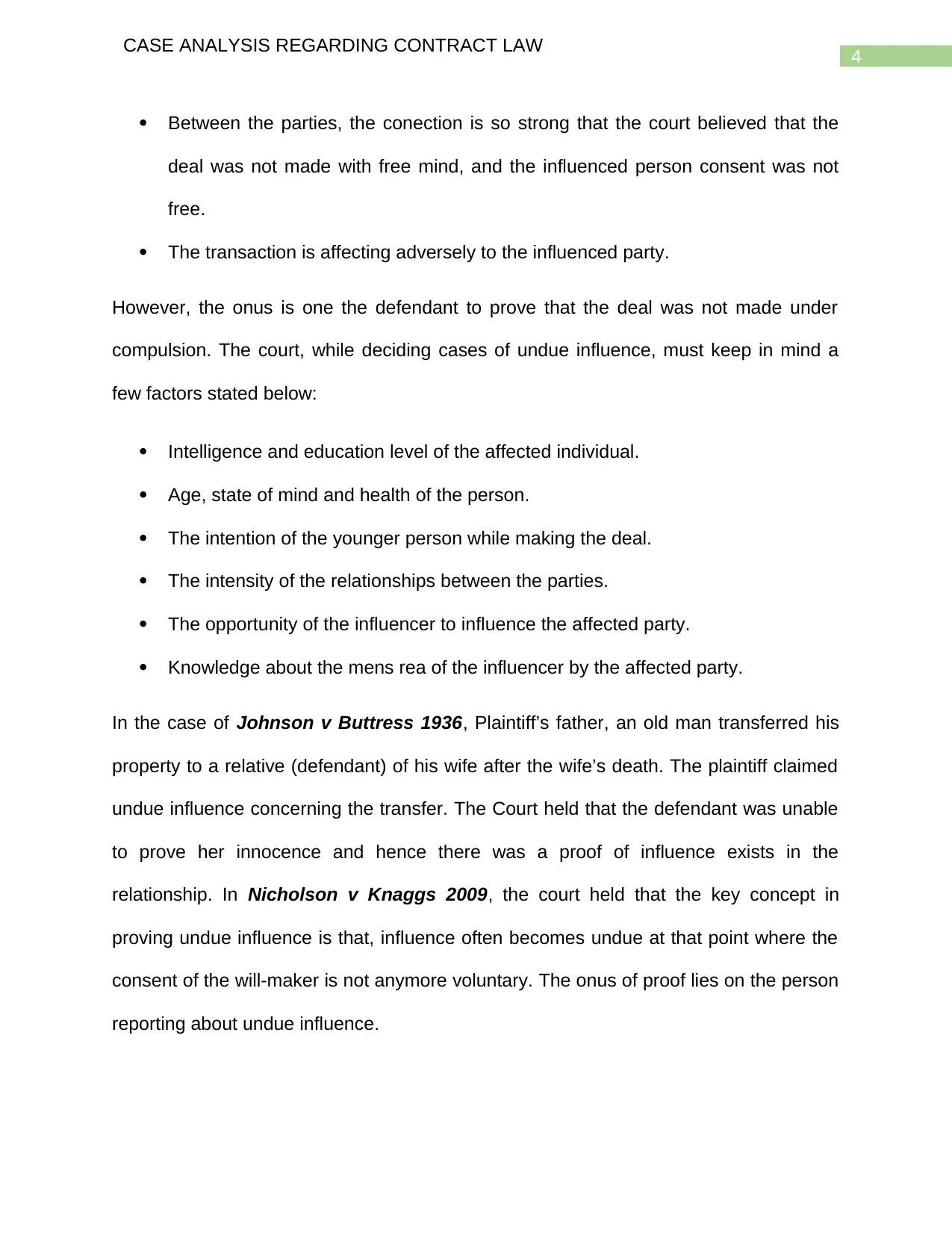
4
CASE ANALYSIS REGARDING CONTRACT LAW
Between the parties, the conection is so strong that the court believed that the
deal was not made with free mind, and the influenced person consent was not
free.
The transaction is affecting adversely to the influenced party.
However, the onus is one the defendant to prove that the deal was not made under
compulsion. The court, while deciding cases of undue influence, must keep in mind a
few factors stated below:
Intelligence and education level of the affected individual.
Age, state of mind and health of the person.
The intention of the younger person while making the deal.
The intensity of the relationships between the parties.
The opportunity of the influencer to influence the affected party.
Knowledge about the mens rea of the influencer by the affected party.
In the case of Johnson v Buttress 1936, Plaintiff’s father, an old man transferred his
property to a relative (defendant) of his wife after the wife’s death. The plaintiff claimed
undue influence concerning the transfer. The Court held that the defendant was unable
to prove her innocence and hence there was a proof of influence exists in the
relationship. In Nicholson v Knaggs 2009, the court held that the key concept in
proving undue influence is that, influence often becomes undue at that point where the
consent of the will-maker is not anymore voluntary. The onus of proof lies on the person
reporting about undue influence.
CASE ANALYSIS REGARDING CONTRACT LAW
Between the parties, the conection is so strong that the court believed that the
deal was not made with free mind, and the influenced person consent was not
free.
The transaction is affecting adversely to the influenced party.
However, the onus is one the defendant to prove that the deal was not made under
compulsion. The court, while deciding cases of undue influence, must keep in mind a
few factors stated below:
Intelligence and education level of the affected individual.
Age, state of mind and health of the person.
The intention of the younger person while making the deal.
The intensity of the relationships between the parties.
The opportunity of the influencer to influence the affected party.
Knowledge about the mens rea of the influencer by the affected party.
In the case of Johnson v Buttress 1936, Plaintiff’s father, an old man transferred his
property to a relative (defendant) of his wife after the wife’s death. The plaintiff claimed
undue influence concerning the transfer. The Court held that the defendant was unable
to prove her innocence and hence there was a proof of influence exists in the
relationship. In Nicholson v Knaggs 2009, the court held that the key concept in
proving undue influence is that, influence often becomes undue at that point where the
consent of the will-maker is not anymore voluntary. The onus of proof lies on the person
reporting about undue influence.
Secure Best Marks with AI Grader
Need help grading? Try our AI Grader for instant feedback on your assignments.
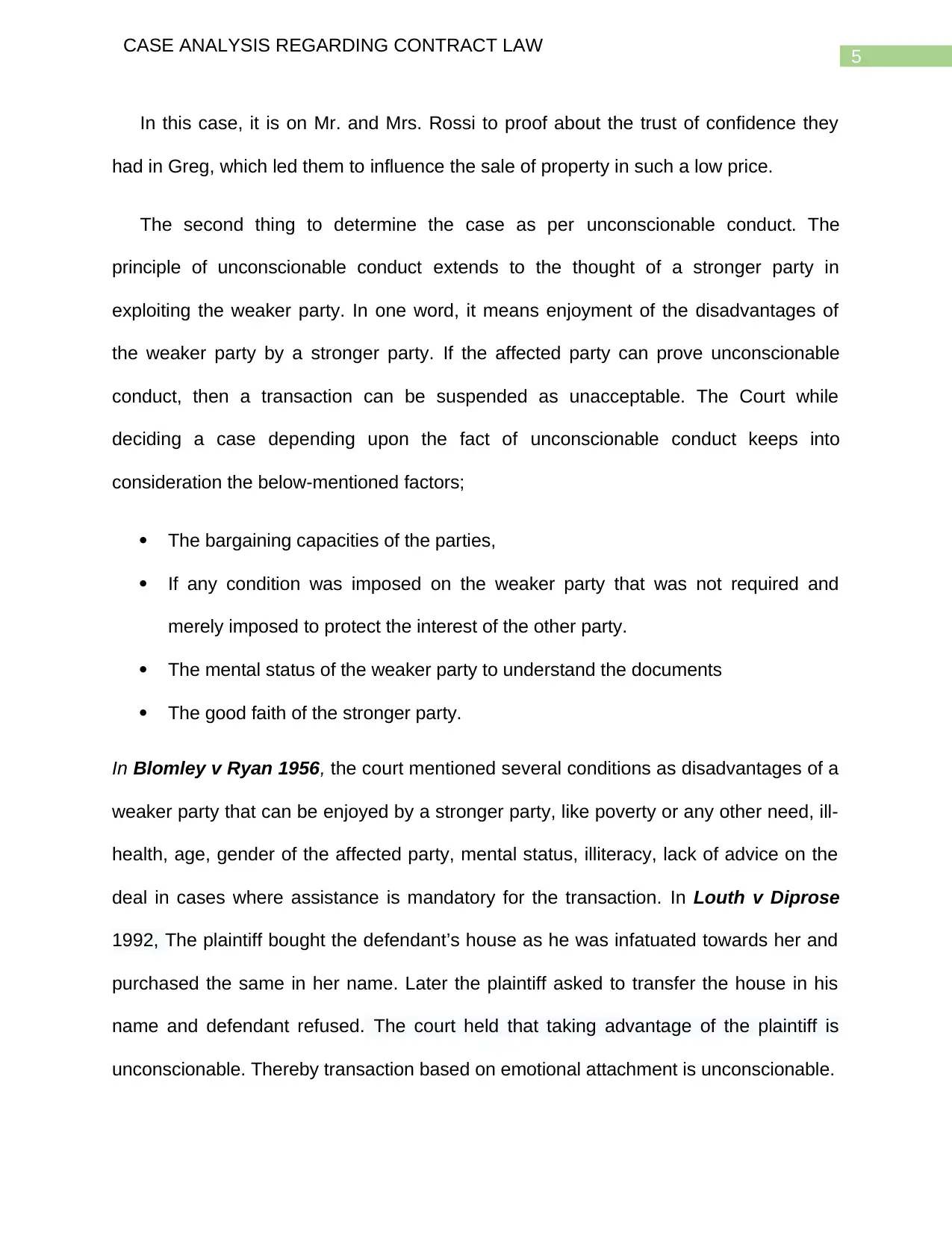
5
CASE ANALYSIS REGARDING CONTRACT LAW
In this case, it is on Mr. and Mrs. Rossi to proof about the trust of confidence they
had in Greg, which led them to influence the sale of property in such a low price.
The second thing to determine the case as per unconscionable conduct. The
principle of unconscionable conduct extends to the thought of a stronger party in
exploiting the weaker party. In one word, it means enjoyment of the disadvantages of
the weaker party by a stronger party. If the affected party can prove unconscionable
conduct, then a transaction can be suspended as unacceptable. The Court while
deciding a case depending upon the fact of unconscionable conduct keeps into
consideration the below-mentioned factors;
The bargaining capacities of the parties,
If any condition was imposed on the weaker party that was not required and
merely imposed to protect the interest of the other party.
The mental status of the weaker party to understand the documents
The good faith of the stronger party.
In Blomley v Ryan 1956, the court mentioned several conditions as disadvantages of a
weaker party that can be enjoyed by a stronger party, like poverty or any other need, ill-
health, age, gender of the affected party, mental status, illiteracy, lack of advice on the
deal in cases where assistance is mandatory for the transaction. In Louth v Diprose
1992, The plaintiff bought the defendant’s house as he was infatuated towards her and
purchased the same in her name. Later the plaintiff asked to transfer the house in his
name and defendant refused. The court held that taking advantage of the plaintiff is
unconscionable. Thereby transaction based on emotional attachment is unconscionable.
CASE ANALYSIS REGARDING CONTRACT LAW
In this case, it is on Mr. and Mrs. Rossi to proof about the trust of confidence they
had in Greg, which led them to influence the sale of property in such a low price.
The second thing to determine the case as per unconscionable conduct. The
principle of unconscionable conduct extends to the thought of a stronger party in
exploiting the weaker party. In one word, it means enjoyment of the disadvantages of
the weaker party by a stronger party. If the affected party can prove unconscionable
conduct, then a transaction can be suspended as unacceptable. The Court while
deciding a case depending upon the fact of unconscionable conduct keeps into
consideration the below-mentioned factors;
The bargaining capacities of the parties,
If any condition was imposed on the weaker party that was not required and
merely imposed to protect the interest of the other party.
The mental status of the weaker party to understand the documents
The good faith of the stronger party.
In Blomley v Ryan 1956, the court mentioned several conditions as disadvantages of a
weaker party that can be enjoyed by a stronger party, like poverty or any other need, ill-
health, age, gender of the affected party, mental status, illiteracy, lack of advice on the
deal in cases where assistance is mandatory for the transaction. In Louth v Diprose
1992, The plaintiff bought the defendant’s house as he was infatuated towards her and
purchased the same in her name. Later the plaintiff asked to transfer the house in his
name and defendant refused. The court held that taking advantage of the plaintiff is
unconscionable. Thereby transaction based on emotional attachment is unconscionable.
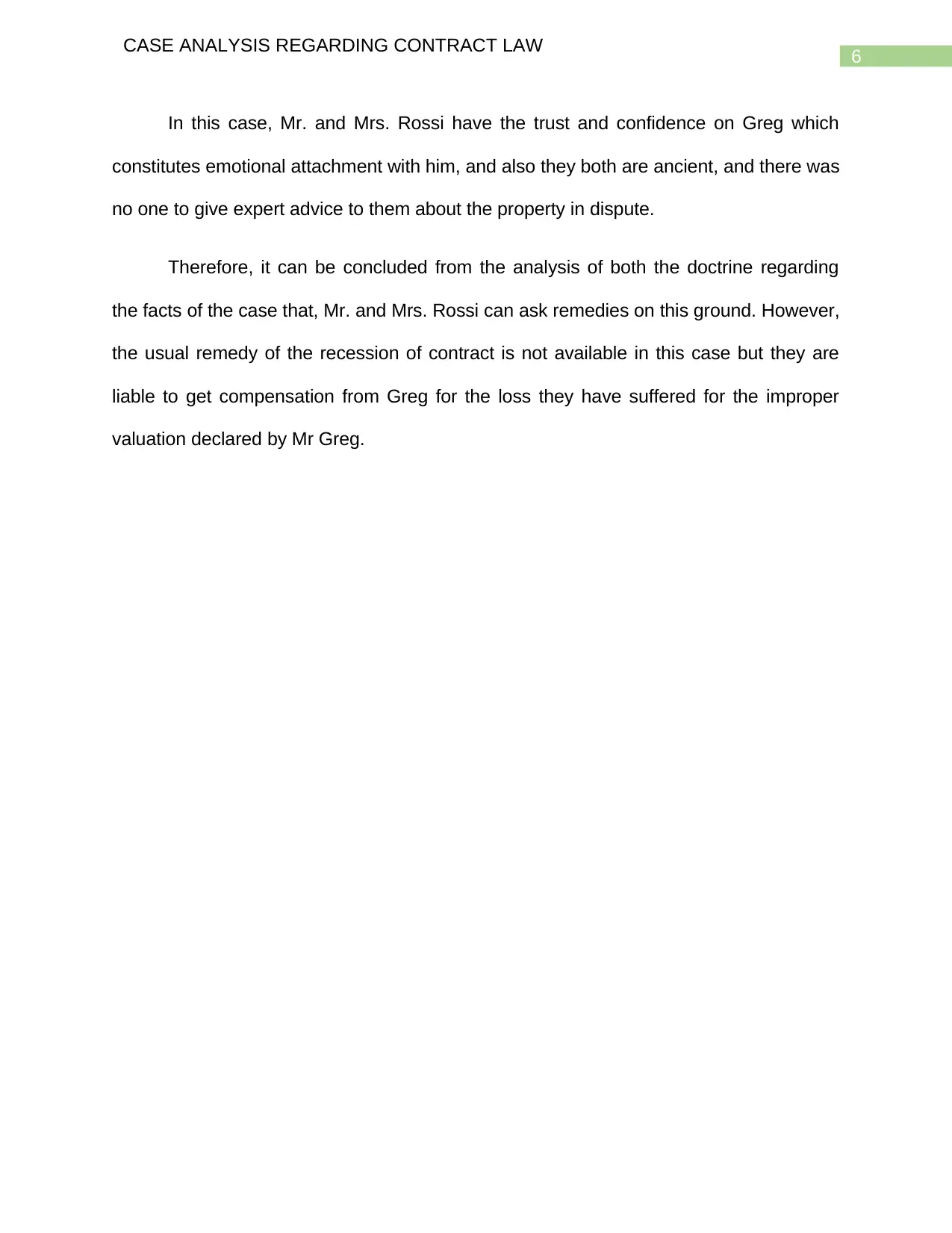
6
CASE ANALYSIS REGARDING CONTRACT LAW
In this case, Mr. and Mrs. Rossi have the trust and confidence on Greg which
constitutes emotional attachment with him, and also they both are ancient, and there was
no one to give expert advice to them about the property in dispute.
Therefore, it can be concluded from the analysis of both the doctrine regarding
the facts of the case that, Mr. and Mrs. Rossi can ask remedies on this ground. However,
the usual remedy of the recession of contract is not available in this case but they are
liable to get compensation from Greg for the loss they have suffered for the improper
valuation declared by Mr Greg.
CASE ANALYSIS REGARDING CONTRACT LAW
In this case, Mr. and Mrs. Rossi have the trust and confidence on Greg which
constitutes emotional attachment with him, and also they both are ancient, and there was
no one to give expert advice to them about the property in dispute.
Therefore, it can be concluded from the analysis of both the doctrine regarding
the facts of the case that, Mr. and Mrs. Rossi can ask remedies on this ground. However,
the usual remedy of the recession of contract is not available in this case but they are
liable to get compensation from Greg for the loss they have suffered for the improper
valuation declared by Mr Greg.
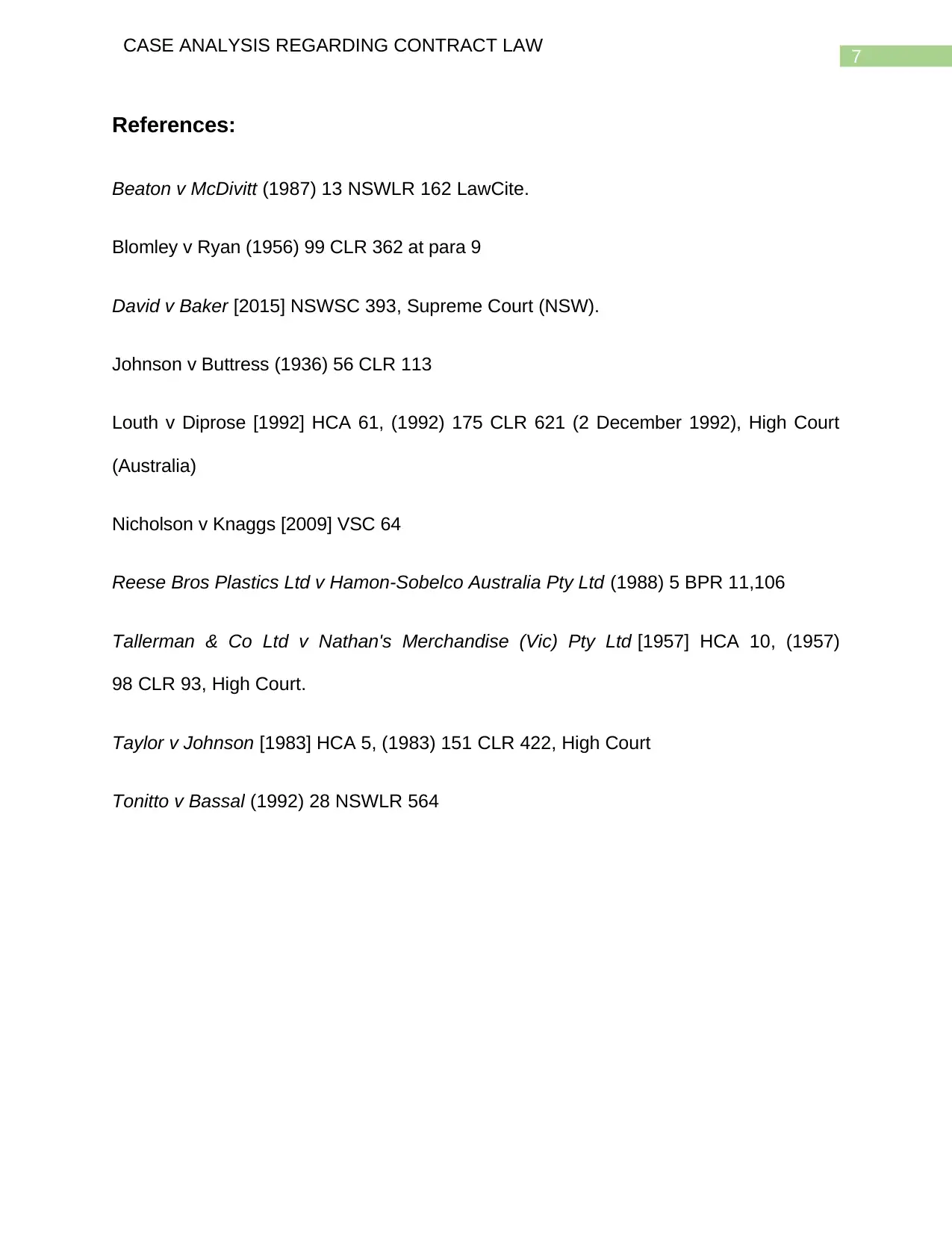
7
CASE ANALYSIS REGARDING CONTRACT LAW
References:
Beaton v McDivitt (1987) 13 NSWLR 162 LawCite.
Blomley v Ryan (1956) 99 CLR 362 at para 9
David v Baker [2015] NSWSC 393, Supreme Court (NSW).
Johnson v Buttress (1936) 56 CLR 113
Louth v Diprose [1992] HCA 61, (1992) 175 CLR 621 (2 December 1992), High Court
(Australia)
Nicholson v Knaggs [2009] VSC 64
Reese Bros Plastics Ltd v Hamon-Sobelco Australia Pty Ltd (1988) 5 BPR 11,106
Tallerman & Co Ltd v Nathan's Merchandise (Vic) Pty Ltd [1957] HCA 10, (1957)
98 CLR 93, High Court.
Taylor v Johnson [1983] HCA 5, (1983) 151 CLR 422, High Court
Tonitto v Bassal (1992) 28 NSWLR 564
CASE ANALYSIS REGARDING CONTRACT LAW
References:
Beaton v McDivitt (1987) 13 NSWLR 162 LawCite.
Blomley v Ryan (1956) 99 CLR 362 at para 9
David v Baker [2015] NSWSC 393, Supreme Court (NSW).
Johnson v Buttress (1936) 56 CLR 113
Louth v Diprose [1992] HCA 61, (1992) 175 CLR 621 (2 December 1992), High Court
(Australia)
Nicholson v Knaggs [2009] VSC 64
Reese Bros Plastics Ltd v Hamon-Sobelco Australia Pty Ltd (1988) 5 BPR 11,106
Tallerman & Co Ltd v Nathan's Merchandise (Vic) Pty Ltd [1957] HCA 10, (1957)
98 CLR 93, High Court.
Taylor v Johnson [1983] HCA 5, (1983) 151 CLR 422, High Court
Tonitto v Bassal (1992) 28 NSWLR 564
1 out of 7
Related Documents
Your All-in-One AI-Powered Toolkit for Academic Success.
+13062052269
info@desklib.com
Available 24*7 on WhatsApp / Email
![[object Object]](/_next/static/media/star-bottom.7253800d.svg)
Unlock your academic potential
© 2024 | Zucol Services PVT LTD | All rights reserved.





